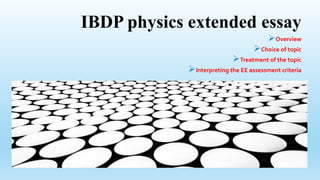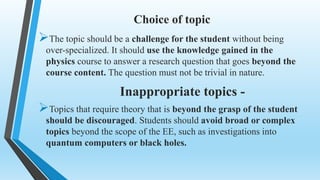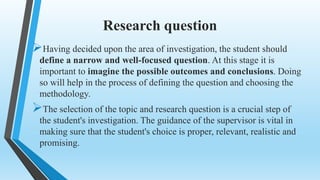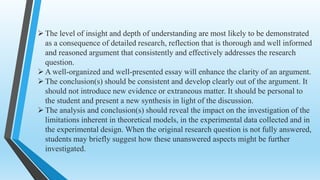Ibdp physics exetended essay and army ppt.pptx
- 1. IBDP physics extended essay ’āśOverview ’āśChoice of topic ’āśTreatment of the topic ’āśInterpreting the EE assessment criteria
- 2. Overview ’āśAn extended essay (EE) in physics should answer a research question in physics through focused, evidence-based argumentation. ’āśThe evidence may be drawn from the studentŌĆÖs personal experimentation and/or book- and internet-based research. Whichever method of research is adopted, the student must use the principles of physics. ’āśThe essay must go beyond simply informing the reader and involve the elements of personal and original thinking.
- 3. Assumptions about the essayŌĆÖs readers ’āśIt should be written for an international peer audience, familiar with the Diploma Programme physics course. The essay can therefore refer to any physics from the course without proof or explanation, eg NewtonŌĆÖs laws. ’āśHowever, material from outside the physics course should be fully explained and referenced where necessary. Students should explain it freshly as it applies to their research question, thereby convincing the reader that they have a genuine grasp of the physics involved. ’āśStudents should also explain any culture-specific matters they refer to in the essay in relation to physics, eg cricket or baseball.
- 4. Choice of topic ’āśThe topic should be a challenge for the student without being over-specialized. It should use the knowledge gained in the physics course to answer a research question that goes beyond the course content. The question must not be trivial in nature. Inappropriate topics - ’āśTopics that require theory that is beyond the grasp of the student should be discouraged. Students should avoid broad or complex topics beyond the scope of the EE, such as investigations into quantum computers or black holes.
- 5. Research question ’āśHaving decided upon the area of investigation, the student should define a narrow and well-focused question. At this stage it is important to imagine the possible outcomes and conclusions. Doing so will help in the process of defining the question and choosing the methodology. ’āśThe selection of the topic and research question is a crucial step of the student's investigation. The guidance of the supervisor is vital in making sure that the student's choice is proper, relevant, realistic and promising.
- 6. Examples of topics These examples are just for guidance. Students must ensure their choice of topic is focused (left-hand column) rather than broad (right-hand column). Focused topics Broad topics The time taken for a single domino to fall depending upon its height and width Falling dominoes The frequency of sound produced by a violin depending on room temperature Musical instruments The rate of diffusion of different gases from an inflated balloon Deflating balloons
- 7. Treatment of the topic ’āśPhysics essays usually have a title, which sums up the essence of the investigation. It is based on the studentŌĆÖs identified topic area. ’āśThe research question further refines and defines the topic. It must be expressed as a question, not a statement. It must be expressed clearly and precisely, and appear early in the introduction of the essay and on the title page of the essay. ’āśFor example, a student may have noticed how it is difficult to spin an uncooked egg. After discussion with the supervisor, the student decides to fill a tin with liquids of different viscosities and roll them down an inclined plane. The title of the essay may be: ŌĆ£The effect of the viscosity of a body on its angular acceleration.ŌĆØ ’āśThe research question, though, should be much more specific: ŌĆ£What is the relationship between the angular acceleration of a cylindrical can rolling down an inclined plane and the viscosity of its contents?ŌĆØ
- 8. Methods of approach ’āśStudents can choose to answer their research question with an essay based solely on theory or one based on data and theory. ’āśIf their essay is data based, students can choose to collect their own primary data or use secondary data that has already been collected elsewhere. ’āśStudents should consider the reliability of both primary and secondary sources at the start of the planning stage. Students must critically evaluate secondary data and the design of the experiment(s) by which they were collected with the same care that they would their own.
- 9. Importance of theory ’āśEvery EE in physics will involve applying relevant theory to the topic selected. Students must ground any experimental work in good background research from existing sources of information. ’āśBefore embarking on experimental work, students must first ensure that there is scope to explore and model the physics that underpins it. A purely empirical investigation that relates a number of variables in the absence of any theoretical foundation is never satisfactory. ’āśFor example, in an investigation relating the index of refraction of a salt solution to its concentration, the student must model the physics relating the index to the concentration.
- 10. Using secondary data ’āśStudents using data collected elsewhere can access all the assessment criteria and achieve the highest marks. For example, they can obtain astronomical data from databases and manipulate it in order to contribute to a research question that looks for the evidence of extrasolar planets. ’āśIdeally, students will manipulate or analyse this secondary data in an original way. Essays that simply restate facts or data taken directly from the sources are of little value. The element of personal analysis and evaluation is extremely important.
- 11. Collecting primary data ’āśStudents should choose experiments that do not require extensive lengths of time for the construction of apparatus. Highly sophisticated instruments are rarely required and can hinder the understanding of a phenomenon. Some of the best EEs have been written by students investigating relatively simple phenomena using standard school apparatus, and this approach is to be encouraged. ’āśStudents must give a clear and concise description of their experimental procedure so that it can be repeated by others. This will normally involve clearly annotated scientific diagrams. Exhaustive lists of equipment and detailed descriptions of procedures should be avoided.
- 12. Theoretical essays ’āśTheoretical essays offer students the challenge of exploring existing material in a new way. This may mean applying the theories and techniques of physics to an unconventional area. ’āśStudents may be tempted to incorporate mathematics or computer science, but they must ensure that the focus of the analysis and evaluation is on the discipline of physics. ’āśWhere computer programs are used and analysed from a physics perspective, they should be placed in the appendix. Each line of code of a program fragment included in the body of the essay will count as two words towards the word limit.
- 13. Examples of topics, research questions and suggested approaches ’āśOnce students have identified their topic and written their research question, they can decide how to research their answer. They may find it helpful to write a statement outlining their broad approach. These examples are for guidance only. Topic The relationship between the dimensions of an exhaust pipe and the sound it emits Research question What is the relationship between the length of an exhaust pipe and the frequency of the sound it emits? Approach A clear opportunity for theory here and this can be supported by a student-designed simulation. Conducting the experiments may be difficult but can be achieved by analysing the recorded sound.
- 14. Example 2 Topic The time taken to reach terminal velocity Research question How does the time taken to reach terminal velocity depend upon the viscosity of the fluid it is falling through? Approach This is a good opportunity for experimentation using a viscous liquid. Quantitatively measuring viscosity and changing the viscosity without changing other variables will provide additional challenges. Mathematically modelling using a spreadsheet simulation will help to determine the expected answer.
- 15. Example 3 Topic The temperature dependence of the sound of flowing water Research question How does the frequency spectrum of the sound of running water depend upon its temperature? Approach This would be a very doable challenge. The student would be expected to do the experiment and also to find some way of accounting for and modelling the change of frequency observed.
- 16. An important note on ŌĆ£double-dippingŌĆØ ’āśStudents must ensure that their EE does not duplicate other work they are submitting for the Diploma Programme. For example, the same experiments cannot be used for the EE and the internal assessment or other practical work carried out during the course.
- 17. The physics EE and internal assessment ’āśIn particular, an EE in physics is not an extension of the internal assessment (IA) task. Students must ensure that they understand the differences between the two. ’āśThe IA is more likely to focus on the syllabus content, whereas the EE can explore aspects of physics not covered in the syllabus. ’āśThe IA must include data collection and analysis (from hands-on experiments, databases, simulations or modelling) and cannot purely be a literature review. ’āśThe EE must construct a theoretical framework for the underlying physics of the chosen topic, whereas the IA focuses on the application of the scientific method to a problem of interest and will only include some background information. ’āśThe EE explicitly assesses the studentsŌĆÖ ability to analyse and evaluate scientific arguments. # Supervisors play an important role in guiding students on these distinctions. Students risk their diploma if academic misconduct is detected.
- 18. Interpreting the EE assessment criteria Criterion A: Focus and method (Strands: Topic, Research question, Methodology) The title of the essay should: ’āśreflect the essence of the investigation ’āśby itself clearly describe the topic or aim of the essay ’āśnot be too long ’āśbe clarified, if necessary, early in the essay ’āśbe different from the research question ’āśusually be presented as a statement.
- 19. ’āśEarly in the essay the student should also outline the area of the research and the purpose and focus of the essay to clearly establish the context of the research question. It is usually appropriate to identify the physics principles relevant to the research question. ’āśFor example, a brief description of the motion of a cylindrical magnet falling inside a copper pipe will include the application of the laws of electromagnetic induction as well as NewtonŌĆÖs laws of motion. ’āśFor this, the student should write a qualitative description of the forces acting on the falling magnet, and their possible variations along its path. Their description could usefully include diagram(s) and perhaps a sketch graph.
- 20. ’āśA formal development of the theory relevant to the research question follows later on in the essay. ’āśThe research question must be centred on physics as a science. It must not focus on peripheral issues, such as the history of physics or social implications of discoveries in physics. ’āśThe way in which students plan their investigation will depend on the approach they choose. They must demonstrate that their chosen methods and materials do address the research question. ’āśIf the essay is data-based, studentsŌĆÖ planning should include: ’āś the relevant physics theory based on reliable and appropriate literature research ’āś an appreciation of the uncertainties and limitations of techniques and apparatus for data collection. ’āśStudents must explain clearly the rationale for choosing their particular experimental methods. However, preliminary work should not be part of the core of the essay. ’āśIf their study is based on the research of secondary data, students need to ensure that the selection of sources is sufficiently wide and reliable.
- 21. Criterion B: Knowledge and understanding (Strands: Context, Subject-specific terminology and concepts) ’āśThe essay must show clear evidence of understanding of the physics focused on in the essay. ’āśIt is not required to explain fundamental laws of physics or general knowledge that are applied in the investigation. ’āśSources relevant to the research question should be effectively referenced and incorporated into the body of the essay in a way that demonstrates the student's understanding. ’āśA theoretical dimension must be part of any empirical investigation. For this purpose, students should develop their own model or use material from acknowledged sources in a relevant and appropriate way. ’āśThe relative weight given to literature sources will depend on the approach chosen by the student. ’āśStudents should make sure definitions are clearly stated if the material being discussed lies outside the IB physics course. Students must make sure that all steps in their reasoning are clearly understood. Students need to demonstrate that they fully understand what they are doing.
- 22. ’āśPhysics terminology relevant to the research question should be used appropriately and explained to show understanding. ’āśThe essential quality of the language relates to exactness and precision, and typical expressions, such as ŌĆ£function ofŌĆØ or ŌĆ£proportional toŌĆØ, carry specific meanings. A curve on a graph cannot be qualified as ŌĆ£exponentialŌĆØ or ŌĆ£quadraticŌĆØ without prior proper analysis. ’āśAny symbols used must be clearly and fully identified in the context of the situation and must be applied consistently throughout the essay. For example, writing ŌĆ£ t for timeŌĆØ would not be sufficient but writing ŌĆ£ t for time during which the magnetic force is appliedŌĆØ would be precise and helpful. ’āśAppropriate and precise physics terminology includes units. ’āśOnly SI standards must be applied to numerical expressions associated with uncertainty and units. ’āśThe use of annotated diagrams for set-up, theory and analysis is an efficient and highly useful tool of communication in physics. It should be part of the studentŌĆÖs physics language and properly integrated.
- 23. Criterion C: Critical thinking (Strands: Research, Analysis and Discussion and evaluation) ’āśThe research sources and collected data in an investigation must be essentially and consistently relevant to, and focused on, the research question. ’āśStudents must demonstrate the ability to apply their method and selected sources effectively in support of their argument. ’āśStudents should use mathematics as a tool without it replacing the relevant physics or becoming the goal itself. For example, in data analysis the student should show an understanding of the statistics and mathematical relationships produced automatically by software programs and pay attention to uncertainties and significant digits of quoted fit parameters. ’āśAny automatic software curve-fitting and parameter estimation, eg polynomials of degree n, must be justified within a meaningful physics model or theory. ’āśStatistics should not override physics. A purely empirical approach will not achieve the highest band of this criterion.
- 24. ’āśStudents should be able to manipulate properly significant digits and uncertainties, especially uncertainty in the mean and in graphs. They should also understand propagation of errors, where appropriate. ’āśStudents need to demonstrate understanding of the intrinsic limitations of an investigation, and their implications for the conclusions reached. They should demonstrate how a given proposed limitation impacts the final results and conclusion, such as where experimental results are compared with standard values. ’āśStudents must evaluate the validity and reliability of data and information from sources. They should comment on the quality, balance and quantity of the sources and data used. ’āśThroughout the essay, students should present a clear, coherent and focused argument based on the research question. Personal views should not simply be stated but must be supported by reasoned argument to persuade the reader of their validity. ’āśStraightforward descriptive or narrative accounts that lack analysis do not usually advance an argument and should be avoided.
- 25. ’āśThe level of insight and depth of understanding are most likely to be demonstrated as a consequence of detailed research, reflection that is thorough and well informed and reasoned argument that consistently and effectively addresses the research question. ’āśA well-organized and well-presented essay will enhance the clarity of an argument. ’āśThe conclusion(s) should be consistent and develop clearly out of the argument. It should not introduce new evidence or extraneous matter. It should be personal to the student and present a new synthesis in light of the discussion. ’āśThe analysis and conclusion(s) should reveal the impact on the investigation of the limitations inherent in theoretical models, in the experimental data collected and in the experimental design. When the original research question is not fully answered, students may briefly suggest how these unanswered aspects might be further investigated.
- 26. Criterion D: Presentation (Strands: Structure, Layout) ’āśThis criterion relates to the extent to which the essay conforms to current academic standards regarding the way in which research papers should be presented. It also relates to how well these elements support the reading, understanding and evaluation of the essay. ’āśStudents must provide a section and subsection structure to their essays, with appropriate informative headings. ’āśIn experimental investigations, a scientific annotated diagram can efficiently introduce key elements of the set-up. Only relevant details of key equipment should be given and exhaustive lists of equipment avoided. A summary of the essential procedural steps in a scientific paper style is expected rather than a cookbook recipe approach. ’āśAny graphs, figures or tables generated by students or taken from literature sources included in the essay must be carefully selected and labelled. They should only be used if they are directly relevant to the research question, contribute towards the understanding of the argument and are of a good graphic quality. Clarity in tables and graphs is important and students should not use unnecessary over-formatting that may detract from communication. ’āśA representative sample of raw data collected in large amounts by the student must be included in the core of the essay in a data table including uncertainties and units. The rest of the raw data should be in the appendix where they should be carefully labelled. Tables of processed data in the core of the essay should be designed to clearly display the information in the most appropriate form.
- 27. ’āś Graphs drawn from the analysed data should be selected to highlight only the most pertinent aspects related to the argument. Too many graphs and data tables will detract from the overall quality of the communication and interrupt the development of the argument. ’āś Only processed data, graphs, diagrams or images that are central to the argument of the essay should be included in the body of the essay, as close as possible to its first reference in the text. ’āś Data tables should enhance a written explanation; they should not themselves include significant bodies of text. If they do, then these words will be included in the word count. ’āś The use of a summary table and the combination of multiple graphs into one graph (family of curves) will avoid unnecessary repetitions. Equations referred to in the text should be numbered. ’āś A bibliography is an essential structural element, contributing as far as it is visually presented, to criterion D, in addition to the other presentation requirements: title page, table of contents, page numbers, and so on. ’āś While there is no explicit penalty in criterion D for exceeding 4,000 words, students should be aware that examiners will not read beyond the 4,000-word limit, therefore affecting the application of multiple criteria. Criterion D specifically may be impacted if, in exceeding 4,000 words, one of the structural requirements of the essay (for example, the conclusion, or important illustrative material) is unassessed by the examiner because he or she is not required to read beyond 4,000 words.
- 28. ’āśAny material that is not original must be carefully acknowledged, with specific attention paid to the acknowledgement and referencing of quotes and ideas. This acknowledgment and referencing is applicable to audiovisual material, text, graphs and data published in print and electronic sources. If the referencing does not meet the minimum standard as indicated in the guide (name of author, date of publication, title of source and page numbers, as applicable), and is not consistently applied, work will be considered as a case of possible academic misconduct. Incomplete references and those that do not meet the minimum requirements as detailed in the Effective citing and referencing document are not penalized in criterion D, but examiners are required to alert the IB to candidates who overlook these minimum requirements, for further investigation. Criterion D assesses references and bibliography purely on how they are presented (for example, consistent, laid out in an appropriate academic manner).
- 29. Criterion E: Engagement (Strands: Reflections on planning and progress) ’āśThis criterion assesses the studentŌĆÖs engagement with their research focus and the research process. It will be applied by the examiner at the end of the assessment of the essay, and is based solely on the candidateŌĆÖs reflections as detailed on the RPPF, with the supervisory comments and extended essay itself as context. ’āśStudents are expected to provide reflections on the decision-making and planning process undertaken in completing the essay. Students must demonstrate how they arrived at a topic as well as the methods and approach used. This criterion assesses the extent to which a student has evidenced the rationale for decisions made throughout the planning process and the skills and understandings developed.
- 30. ’āśFor example, students may reflect on: ’āśthe approach and strategies they chose, and their relative success ’āśthe Approaches to learning skills they have developed and their effect on the student as a learner ’āśhow their conceptual understandings have developed or changed as a result of their research ’āśchallenges they faced in their research and how they overcame these ’āśquestions that emerged as a result of their research ’āśwhat they would do differently if they were to undertake the research again.
- 31. ’āśEffective reflection highlights the journey the student has engaged in through the EE process. Students must show evidence of critical and reflective thinking that goes beyond simply describing the procedures that have been followed. ’āśThe reflections must provide the examiner with an insight into student thinking, creativity and originality within the research process. The student voice must be clearly present and demonstrate the learning that has taken place.































